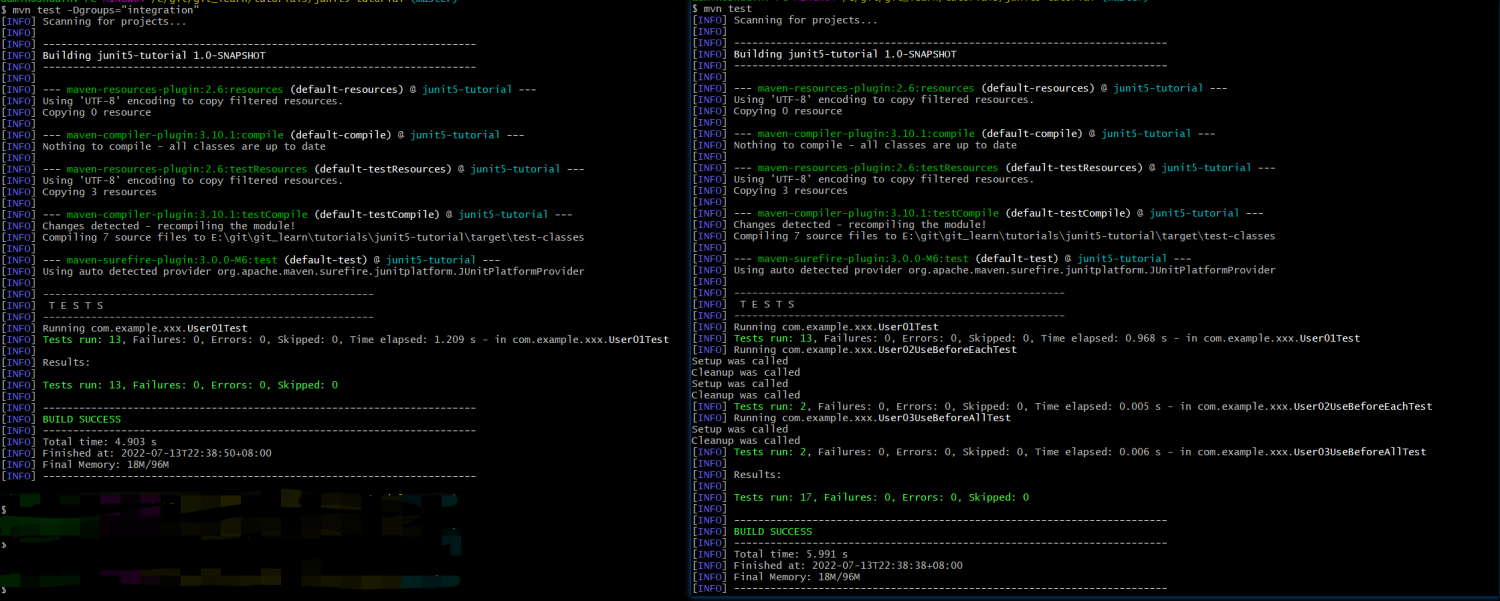概述
写测试用例对于开发来说有2点好处,一是开发阶段写完的功能可以快速验证,第二就是在后期需求变动或修改BUG后可以快速测试当前改动是否带来其它问题。下面就了解一下Junit5写测试用例。
准备
创建一个maven项目
mkdir junit5-tutorial
cd junit5-tutorial
mkdir -p src/main/java
mkdir -p src/test/java
mkdir -p src/main/resources
mkdir -p src/test/resources
# 编写pom.xml
vi pom.xml
添加依赖
- 引入第三方断言库assertj
- 支持json测试
- 支持xml测试
pom.xml
<?xml version="1.0" encoding="UTF-8"?>
<project xmlns="http://maven.apache.org/POM/4.0.0" xmlns:xsi="http://www.w3.org/2001/XMLSchema-instance"
xsi:schemaLocation="http://maven.apache.org/POM/4.0.0 http://maven.apache.org/xsd/maven-4.0.0.xsd">
<modelVersion>4.0.0</modelVersion>
<groupId>com.example.xxx</groupId>
<artifactId>junit5-tutorial</artifactId>
<version>1.0-SNAPSHOT</version>
<name>junit5-tutorial</name>
<url>https://www.xxx.com</url>
<properties>
<project.build.sourceEncoding>UTF-8</project.build.sourceEncoding>
<maven.compiler.source>17</maven.compiler.source>
<maven.compiler.target>17</maven.compiler.target>
</properties>
<build>
<pluginManagement>
<plugins>
<!-- 在这里声明的目的是使用指定的版本 -->
<!-- 执行测试用例任务的插件,默认绑定test生命周期的test阶段 -->
<plugin>
<artifactId>maven-surefire-plugin</artifactId>
<version>3.0.0-M6</version>
</plugin>
<!-- 用来执行编译任务的插件,默认绑定default生命周期compile阶段 -->
<plugin>
<artifactId>maven-compiler-plugin</artifactId>
<version>3.10.1</version>
</plugin>
</plugins>
</pluginManagement>
</build>
<dependencyManagement>
<dependencies>
<!-- XML Unit - Dependency Management -->
<dependency>
<groupId>net.bytebuddy</groupId>
<artifactId>byte-buddy</artifactId>
<version>1.12.10</version>
</dependency>
<dependency>
<groupId>net.bytebuddy</groupId>
<artifactId>byte-buddy-agent</artifactId>
<version>1.12.10</version>
<scope>test</scope>
</dependency>
<!-- Mockito Dependency -->
<dependency>
<groupId>org.mockito</groupId>
<artifactId>mockito-junit-jupiter</artifactId>
<version>4.5.1</version>
<scope>test</scope>
</dependency>
</dependencies>
</dependencyManagement>
<dependencies>
<dependency>
<groupId>org.assertj</groupId>
<artifactId>assertj-core</artifactId>
<version>3.22.0</version>
<scope>test</scope>
</dependency>
<dependency>
<groupId>io.github.classgraph</groupId>
<artifactId>classgraph</artifactId>
<version>4.8.146</version>
</dependency>
<dependency>
<groupId>org.junit.jupiter</groupId>
<artifactId>junit-jupiter</artifactId>
<version>5.8.2</version>
</dependency>
<!-- JSON Unit - Dependencies -->
<dependency>
<groupId>net.javacrumbs.json-unit</groupId>
<artifactId>json-unit-assertj</artifactId>
<version>2.33.0</version>
<scope>test</scope>
</dependency>
<dependency>
<groupId>com.fasterxml.jackson.core</groupId>
<artifactId>jackson-databind</artifactId>
<version>2.13.2.2</version>
</dependency>
<dependency>
<groupId>com.fasterxml.jackson.datatype</groupId>
<artifactId>jackson-datatype-jsr310</artifactId>
<version>2.13.2</version>
</dependency>
<!-- XML Unit - Dependencies -->
<dependency>
<groupId>org.xmlunit</groupId>
<artifactId>xmlunit-assertj</artifactId>
<version>2.9.0</version>
<scope>test</scope>
</dependency>
</dependencies>
</project>
创建一个User
public record User(String name, Integer age, Boolean blocked, LocalDate birthDate) {
}
测试
测试用例命名最佳实践
首先测试类名应该以Test结尾,测试用例名称最好遵从以下规则
- 测试名称应表达特定要求
- 测试名称应包含预期的输入或预期的结果
- 测试名称应以陈述的形式
具体参考:https://osherove.com/blog/2005/4/3/naming-standards-for-unit-tests.html
断言
@Test
@DisplayName("User should be at least 18")
void user_should_be_at_least_18() {
// junit5 的断言
assertTrue(user.age() >= 18);
// assertj 的断言
assertThat(user.age()).isGreaterThanOrEqualTo(18);
}
显示名称
测试类和测试方法可以声明自定义显示名称,可以使用空格、特殊字符、甚至emojis表情符号,这些名称会在runner和测试报告中显示。

参数化测试
参数化测试可以用不同的参数多次运行测试。它们和普通的@Test方法一样声明,但是使用@ParameterizedTest注解。还必须声明至少一个将为每次调用提供参数的来
使用@ValueSource来指定参数来源
它可以指定一个原生类型的数组,并且只能为每次调用提供一个参数
@ParameterizedTest
@ValueSource(ints = {20, 50, 80})
void test_value_source(int age) {
assertThat(age).isGreaterThanOrEqualTo(18);
}
读取CSV文件内容作为参数来源
它可以让你使用classpath中的csv文件。csv文件中的每一行都会导致参数测试的一次调用
src/test/resources/friends.csv
name,age
lisa,20
hans,30
hanna,40
@ParameterizedTest
@CsvFileSource(resources = "/friends.csv", numLinesToSkip = 1)
void test_value_source_by_csv_file_source(String name, int age) {
assertThat(age).isGreaterThanOrEqualTo(18);
}
标签
我们可以给测试类或测试用例上面通过@Tag加标签,执行测试的时候可以指定标签,从而达到为测试用例分组的目的。
下面就给测试类打上一个integration的标签
@Tag("integration")
class User01Test {
// ...
}
可以使用如下命令来指定要执行的测试用例:
mvn test -Dgroups="integration"

左侧只执行了Running com.example.xxx.User01Test一个测试类,右侧则执行了3个
总结
本文介绍了如何使用Junit5写测试用例。
参考
- Unit test naming best practices Unit test naming best practices - Stack Overflow
- https://osherove.com/blog/2005/4/3/naming-standards-for-unit-tests.html
- AssertJ Homepage https://assertj.github.io/doc/
- Gradle: https://stackoverflow.com/a/64986861
- https://junit.org/junit5/docs/current/user-guide/#running-tests-tag-expressions
- further reading
- JUnit 5 User Guide
- JUnit 5 中文文档 https://doczhcn.gitbook.io/junit5/
- AssertJ - fluent assertions java library
- Jupiter / JUnit 5 - Testcontainers
- awaitility/awaitility: Awaitility is a small Java DSL for synchronizing asynchronous operations (github.com)